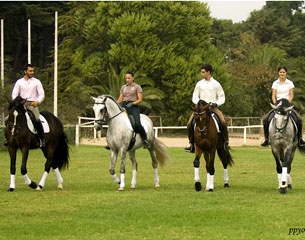
There has always been vigorous debate over the best way to train for dressage. The right way, the wrong way, the good way, the bad way. For a young rider team training in Portugal, their methods are based on the teachings of the great Nuno Oliveira.
“Classical dressage started with him, didn’t it?” says Portugal’s Gonçalo Ribeiro.
In actual fact, classical training dates back centuries, and was first used in cavalry movements and to prepare the horse for the battlefield.
Nuno based his teachings on the methods put forward by several equine scholars, such as François Robichon de La Guérinière, Gustav Steinbrecht and François Baucher, who studied the art of equestrianism throughout the 17th and 18th centuries.
“We are lucky to have such a rich equine history in Europe, a history that evolved because for centuries the horse was relied upon for survival, and it was vital that humans learn to work with, and understand the horse,” says Gonçalo.
“Today the situation is different, as there are few people whose lives revolve around the horse, and so we forget that we must FIRST understand the theory of riding, and then go to practice. Classical riding provides us with a solid theory, based on the principle of harmony between horse and rider. Riding then becomes an art, based on the steps to develop a sense of well being on horseback.”
The Classical Young Rider Team
It is this theory that is being passed on by the classical masters of our generation and has inspired an acrobat, a cow girl, and two would be vets, to come together and train as a multi-nation Young Rider team.
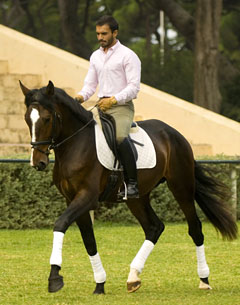 Aiming to achieve their training goals through artistic, technical and classical methods, rather than by force, the four-person squad work together everyday in the hope of one day reaching their own individual goals.
Aiming to achieve their training goals through artistic, technical and classical methods, rather than by force, the four-person squad work together everyday in the hope of one day reaching their own individual goals.
We use the term classical training so often that its meaning is taken for granted. It is assumed that those in dressage circles are well aware of what the term ‘classical’ represents in terms of training. But when confronted, people are often at a loss to explain what ‘classical’ actually means.
“It’s about establishing a harmony with the horse, creating a relationship that allows you to work together with him in all possible environments; outdoors, indoors, competition or training at home,” says oldest team member, (by two days!), 25-year old Laurie Clapeyron.
Born in France, Laurie started riding when she was 6 after visiting a friend who had horses and she has been riding ever since.
“When my father saw how much I loved it, he also gave it a go; so we actually started riding at the same time, and he now owns his own horse property in Northern France.”
Beginning on ponies Laurie tried many breeds and many disciplines before deciding that dressage was for her.
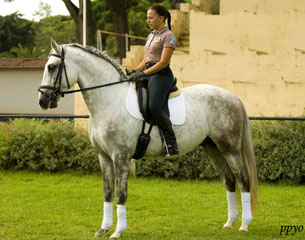 “I did jumping competition, and after school I completed a three year circus course, specializing in the acrobatic form of horse vaulting, which I once hoped to pursue as a career. But I fell in love with the Lusitano and with the art of dressage.”
“I did jumping competition, and after school I completed a three year circus course, specializing in the acrobatic form of horse vaulting, which I once hoped to pursue as a career. But I fell in love with the Lusitano and with the art of dressage.”
For me, an Aussie girl who grew up on a large cattle farm, classical training is a long way from my beginnings mustering cattle on the family farm. My mum had me on a horse before I could walk and by the age of 12 I could crack a stock whip on horseback at full gallop.
After training warmbloods for many years, Mum sent me to Portugal to find a Lusitano, so that she could at last experience the joy of training the chosen horse of her hero, Nuno Oliveira. I soon found Mum her lusitano and sent him to Australia, but for me, Portugal and the art of classical training has become my new home.
All four members of our team went in search of the teachings of the great Master Oliveira, and thus found each other in the stable of Mr João Pedro Rodrigues, whom we are certain is his most renowned disciple! So many horse-minded people in Portugal recognize the talent, wisdom, and, above all, character of the great João Pedro Rodrigues.
Young riders who know him, or have been lucky enough to have trained with him, are constantly inspired by his equestrian knowledge. Many talented riders in Portugal have learned from the 'classical master of our generation'.
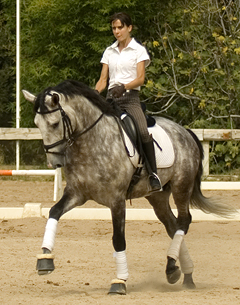 Longest to train with the master, Gonçalo Ribeiro, started with João Pedro back in 2006 and says he is constantly inspired by his training methods and horsemanship.
Longest to train with the master, Gonçalo Ribeiro, started with João Pedro back in 2006 and says he is constantly inspired by his training methods and horsemanship.
“His life long career at the Portuguese School of Equestrian Art, enables him to pass on the knowledge and feeling he has learnt through traditional riding,” says 23-year old Gonçalo.
With a father and brother who rode, at 17 Gonçalo decided to take up the reins, and now says it is his dream to be the best.
Team youngster, 21-year old Francisco Filipe, started at the stable earlier this year, and I was so impressed to witness what just 5 months with a master trainer could do for a passsionate, yet inexperienced young rider.
“My first horse experience was with a friend, who took me galloping through the fields of Southern Portugal and I felt, in this moment, a sense of purpose; I knew then that horses would be my future. This friend put me in contact with João Pedro, and I now train with him everyday, learning to break-in the young lusitanos of his breed.”
Inspired by João Pedro Rodrigues
And what a place to learn to ride! One particular day confirmed my admiration, as João Pedro gave a lesson to three members of his young rider team, switching from French to English to Portuguese, as he engaged Francisco, Laurie and I in one of the most rewarding, and I'm certain, multilingual lessons I have ever had!
“Our training is about working together to help each other; it’s about flexibility and interaction. While one of us is lunging, the other is preparing a horse for, or giving a lesson, to one of the others. This way we all learn and grow together and create the best atmosphere for our training,” says Francisco.
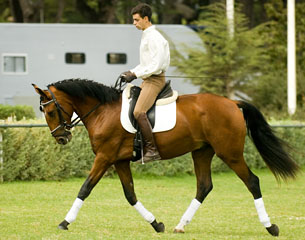 Many training methods focus on engaging the horse from behind and are correct in their attempts to get the horse working over the back, maintaining the ‘swing’ right through to the tail of the horse. However, for our young rider team classical training also stresses the position of the horse's shoulders, the straightness of the horse, and the correct placement of the horses weight. Thus, at the same time as the rider is engaging the hind quarters, the rider is also ensuring this power is not lost ‘out the front or side doors’.
Many training methods focus on engaging the horse from behind and are correct in their attempts to get the horse working over the back, maintaining the ‘swing’ right through to the tail of the horse. However, for our young rider team classical training also stresses the position of the horse's shoulders, the straightness of the horse, and the correct placement of the horses weight. Thus, at the same time as the rider is engaging the hind quarters, the rider is also ensuring this power is not lost ‘out the front or side doors’.
If this power is not controlled, then the horse is simply ‘running into the bit’ and the rider will be forced to hold the horse back with the constant use of strong rein.
François Baucher said that “the education of the horse consists in the complete subjection of his powers. That we can only make use of his powers at will by annulling all resistances and that these resistances have their source in the contractions occasioned by physical defects” (in Baucher, New Method of Horsemanship).
Classical training achieves this goal through the use of lateral exercises, that work on the horse's balance, flexibility, muscle development and position of the hind quarters whilst at the same time ensuring that there are no resistances from the horse, right through his body, from his jaw through to his hind quarters.
A rider should be able to relax the rein, at any point during training, without the horse changing his balance or rhythm in any way. “Descente de main: the rider relaxes his fingers and the horse meanwhile maintains the same pace, the same attitude and the same cadence.” (Nuno Oliveira)
Working According to the Classical Principles
“The worst thing for me in training horses is when a horse has not established a solid foundation and has begun the more difficult movements, before he has properly established his own balance and self-carriage,” says Gonçalo. “A rider needs to think! To be aware of the horse’s maturity, and his mental capability.”
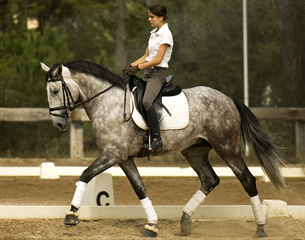 "A horse will never tire of a rider who possesses both tact and sensitivity because he will never be pushed beyond his possibilities." ( Nuno Oliveira)
"A horse will never tire of a rider who possesses both tact and sensitivity because he will never be pushed beyond his possibilities." ( Nuno Oliveira)
Maintaining the roundness and openess in the poll, a horse should begin lateral work in rising trot, all the while focusing on keeping a forward feeling in the movement.
“The most important thing is never to force the horse to be or do anything,” says Laurie.
“Classical training is about creating a relationship with the horse, and then adapting the best methods of training for him, and his physical and mental capability.”
Very important is that the horse develops a sensitivity, or maintains it if he has a natural tendency to go forward. This means that a small touch with the leg should be followed by a response, if not, it should be immediately aided by a whip! That way the horse will learn to respond to the slightest aid, and this should be kept throughout the lateral movements. A rider who needs to constantly push the horse forward is teaching the horse to become numb to the rider's aids, 'dead to the leg', and will therefore have trouble later on with the more advanced movements.
My horse naturally has a lot of power, so his tendency is to put weight into the shoulders if you allow him to drop too low in front. The aim is then to keep the roundness and openess in the poll, while trying to bring the weight up off the shoulders. This is done with the use of exercises and transitions, to engage the horse's hind leg, and ensure he is coming through behind and up over his top line. However it's important that when engaging the hind quarters, the rider is careful not to let the horse fall through the outside shoulder, and thus loose the power and the balance that is coming from behind.
João Pedro would instruct that in a forward trot with the neck low but open and soft, execute shoulder-in down the long side just to half way, then half circle across and shoulder-in back up the other long side. This allows the horse to not lose the flow of the shoulder-in, and also reinforces the outside rein/inside leg concept on the half circle. In particular this exercise enables the rider to check the horse isn't putting weight into the outside shoulder. Riders should be careful to begin the half circle with only outside aids, to gain control of the outside shoulder.
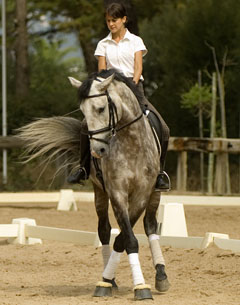 Counter bend is also used up the long side, and then down the centre line into leg-yield in counter bend, helping again to gain control over the horse's shoulder, and engage the hind quarters.
Counter bend is also used up the long side, and then down the centre line into leg-yield in counter bend, helping again to gain control over the horse's shoulder, and engage the hind quarters.
In the canter, we work a lot on the circle, opening and closing the size of the circle, to again shift the horse off the shoulders and produce more jump in the canter. When the canter feels good I was then told to release the contact. If the canter kept the rhythm and the horse stayed balanced, then the weight is in the right spot, if the horse runs, falls onto his nose, or breaks into trot, the horse is not in the right balance.
Finally, and most importantly, the walk! The walk must be always forward, careful not to shorten the walk or let the horse close the gap in the poll. Lateral movements at the walk are most effective to engage the horse, both submissively and physically. On the outside edge of the circle, carefully slow the walk, and then ask a few steps hind-quarters to the outside, keeping the bend in the neck toward the inside. Moving the shoulders, and the quarters at the walk, supples the horse, and reinforces his sensitivity to the riders aids.
And then, transitions, transitions, transitions. don't do 100 transitions, do 1000! João Pedro would ask that I do transitions trot-walk, walk-trot, keeping the bend throughout the downward transition, to prevent the horse from shortening the trot steps and shuffling into the walk. Again the importance is that the horse be always forward, and off the aids, willing and ready to 'search the contact' when he comes to the walk.
Another good learning opportunity was when I was offered a ride on one of the very young horses. On a newly ridden horse the focus is on keeping the horse on the line YOU choose, keeping the forward momentum, and remembering the key rule of the young horse...'legs without hands, hands without legs!'
Compromising Training for Competition?
 The training debate then goes to the discussion of competition, and many argue that the principles of classical training must be compromised for top level competition.
The training debate then goes to the discussion of competition, and many argue that the principles of classical training must be compromised for top level competition.
All four of us dream of competing at Grand Prix level and would argue that if a horse is ‘on the aids’, light and flexible in the hand, forward to the leg, and engaged behind, then the movements of a test are merely a presentation of the horse's talent, and proof of the rider’s skill to maintain the suppleness, flow and harmony that has been his goal.
Classical training is therefore the basis that creates this unique relationship between horse and rider and competition is just the application and demonstration of that relationship.
I love it when the horse and I are one, when all the outside distractions, physical AND mental, disappear. When you can’t remember how thirsty you are, or how tired you might be, and the horse has forgotten about the ‘spooky chair’ or the old dog who's parked himself at X.
You can almost hear the horse waiting for you to tell him how to react, he trusts you to give him the answer, partners working together, and most importantly... ENJOYING it!
Creating “the perfect understanding and harmony between horse and rider” (Nuno Oliveira).
Text by Sarah Warne
Photos © Pedro Yglesias de Oliveira
Related Links
Young Portuguese Star Goncalo Carvalho Inspires Young Riders
The Road to London is Jumping through Hoops for Some Nations